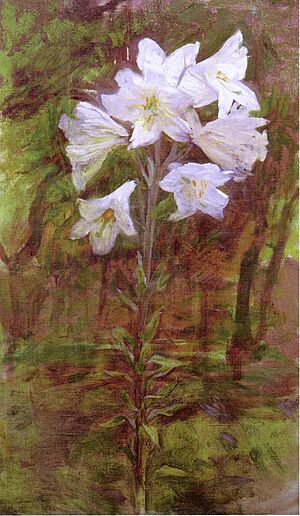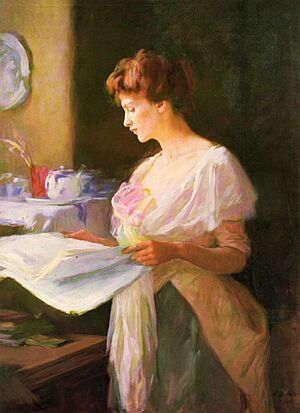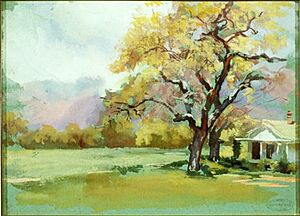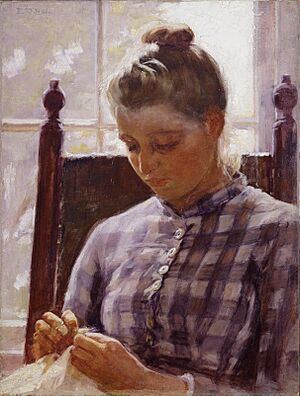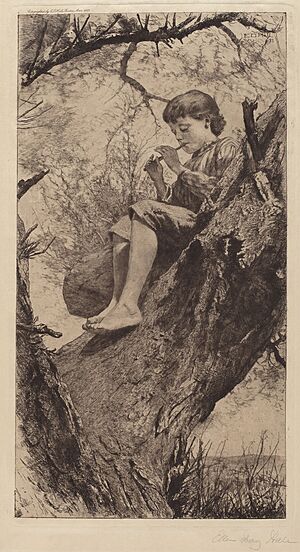Ellen Day Hale facts for kids
Quick facts for kids
Ellen Day Hale
|
|
|---|---|
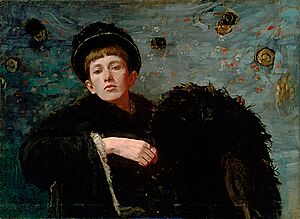
Self-Portrait, oil on canvas, 1885, (28 1/2" x 39") Museum of Fine Arts, Boston
|
|
| Born | February 11, 1855 |
| Died | February 11, 1940 (aged 85) |
| Nationality | American |
| Education | Académie Julian |
| Known for | Painting, printmaking |
Ellen Day Hale (born February 11, 1855 – died February 11, 1940) was an American artist from Boston. She was known for her Impressionist paintings and printmaking. Ellen studied art in Paris and lived in Paris, London, and Boston during her life. Her artwork was shown at famous places like the Paris Salon and the Royal Academy of Arts. Ellen Day Hale also wrote a book about famous artists. She helped many young women artists in New England, making it easier for women to be accepted as artists.
Contents
Biography
Early Life and Family
Ellen Day Hale was born on February 11, 1855, in Worcester, Massachusetts. Her family was well-known in Boston. Her father, Edward Everett Hale, was a writer and speaker. He even worked for the U.S. Senate for a few years. Ellen often helped him with his duties.
Ellen was one of eight children. She helped her parents care for her younger brothers and sisters. From a young age, Ellen was surrounded by art. Her mother encouraged her interest in painting. Her aunt, Susan Hale, who was a watercolor artist, probably gave Ellen her first art lessons. Ellen's brother, Philip Leslie Hale, also became a famous artist. He married Lilian Westcott Hale, who was also an Impressionist painter.
Ellen's family had many strong women who were role models. Her great-aunt was Harriet Beecher Stowe, who wrote the famous anti-slavery book Uncle Tom's Cabin. Other great-aunts included Catharine Beecher, an educator, and Isabella Beecher Hooker, who fought for women's rights. One of Ellen's cousins was Charlotte Perkins Gilman, a writer known for her short story "The Yellow Wallpaper".
Art Education
In 1873, Ellen Day Hale began her art training in Boston. She took private lessons from the painter William Rimmer. At that time, women often had separate art classes from men. Rimmer taught her a lot about drawing and understanding the human body.
A year later, Ellen joined William Morris Hunt's painting school. About forty other women artists were there. Helen M. Knowlton was one of the main teachers at this school. Hunt and Knowlton taught in new ways, like using interpretive sketching. This greatly influenced Ellen's art. Knowlton especially helped create a strong community among the women artists. They supported each other in their art careers and personal lives.
In 1878, Ellen traveled to Philadelphia for more training. She studied for two years at the Pennsylvania Academy of the Fine Arts (PAFA). There, she learned to paint from live models. The director, Thomas Eakins, also focused on studying human anatomy for figure painting.
After PAFA, Ellen traveled through Europe with Helen Knowlton in 1881. They visited museums in Belgium, Holland, Italy, England, and France. They copied famous paintings to learn from them. Then, Ellen moved to Paris to study with French masters. Many young American artists were studying in Paris at this time. She first studied drawing at the Jardin des Plantes. Then she went to Académie Colarossi. The teaching style there was very strict, which was different from her earlier schools.
In September 1882, Hale briefly studied at the Royal Academy of Arts in London. When she returned to Paris, she began training at the Académie Julian. She studied there for three years. Her teachers included famous artists like Tony Robert-Fleury and William-Adolphe Bouguereau. Women were not allowed into the most famous art schools in Paris, like the Ecole des Beaux-Arts. So, they had to go to private academies that charged tuition. Académie Julian, like most private schools, even charged women more money than men. Despite these challenges, Ellen liked Académie Julian the best. She made a close group of friends there who supported her.
Personal Life and Partnerships
Ellen Day Hale was known as a "New Woman." This term described successful, well-trained women artists in the 1800s who often focused on their careers. Ellen never married. However, she found a lifelong friend and fellow artist in Gabrielle de Veaux Clements. They met in 1883 and became close friends in 1885 while studying at the Académie Julian in Paris.
While traveling and studying in Europe together, Clements taught Ellen how to create etchings. In 1893, both artists returned to the United States. They moved into a house together near Gloucester, Massachusetts, which they called "The Thickets." Their friendship provided them with personal happiness and support. This helped them both pursue their professional art careers.
In the 1890s, Ellen moved to Santa Barbara, California, for two years. This may have been to improve her health. In 1904, she moved to Washington, D.C.. There, she helped her father as his hostess while he was working for the U.S. Senate. Even with these family duties, Ellen never stopped painting and making etchings. She continued her art for the rest of her life.
Ellen was also a distant cousin of the painter Margaret Lesley Bush-Brown. They visited France and Belgium together in 1881.
Art Career
Ellen Day Hale was an Impressionist painter. She was best known for her paintings of people, including many portraits and self-portraits. Her paintings were detailed and beautiful, showing great skill with light and shadow.
She exhibited her work at the Boston Art Club in 1876. In Europe, she lived in London and Paris. She showed her paintings An Old Retainer and Un Hiver Americain at the Paris Salon in 1885. In London, her painting A New England Girl was shown at the Royal Academy of Arts. In the United States, she lived in Boston. Her work is connected to the Boston School of art. She made more and more Impressionistic paintings. However, she always kept her focus on painting the human form. Ellen was very active in showing her art, but she only gained some recognition for it.
From 1918 to 1940, Ellen and Gabrielle Clements spent their winters in Charleston, South Carolina. This city was becoming a lively art center. Ellen was very interested in the local culture, and her work from this time shows it. She and Clements helped start the Charleston Etchers' Club in 1923. This group taught printmaking and encouraged artists to share ideas and plan exhibitions. Other artists like Elizabeth O'Neill Verner and Alfred Hutty were also founding members. Ellen and Clements wanted to share their skills. They said, "We want to leave Charleston some of our skills... Get together a group so you can buy a press and we will show you how to use it... We’ll teach you, so you can teach them."
Ellen Day Hale also showed her work at the Palace of Fine Arts during the 1893 World's Columbian Exposition in Chicago.
Famous Paintings
Self-Portrait
Ellen Hale started painting her Self-Portrait in 1884. She worked on it at her family's home in Roxbury, Massachusetts, and their summer home in Matunuck, Rhode Island. The painting shows Ellen looking confidently at the viewer. Her right hand rests slightly over the chair. She wears a black dress with buttons and a fur collar, covered by a loose jacket. Her bangs peek out from a round black hat. At the time, bangs were a popular, youthful hairstyle. Ellen seems to be making a fashion statement with her hair, clothes, and the ostrich-feather fan she holds.
When Ellen first showed the painting to her teachers in 1885, artist William-Adolphe Bouguereau criticized the size and position of her hand. He wanted her to make it "prettier." However, Ellen did not change the hand. She refused to make her work fit the perfect, traditional ideas of beauty. The strong way she painted her hand was also special. It was rare for artists to paint themselves looking directly at the viewer without showing tools of their profession.
When Self-Portrait was shown in Boston in 1887, a critic praised it. They said it showed "a man's strength in the treatment and handling of her subjects." The Museum of Fine Arts, Boston, where the painting is now, later said that Ellen's direct style and strong, dark colors reminded them of Édouard Manet. Manet was known for his bold images with strong light and shadow. Ellen was one of a few women artists of her time who created powerful self-portraits. They bravely showed themselves as strong individuals who challenged ideas about women's place in society. Ellen created an "original and queer" (meaning unusual) picture of herself. This bold statement of her identity makes her self-portrait very important.
June
Ellen Hale's 1893 painting, June, shows a young woman sewing. She wears her hair in a bun and a checked dress. This painting is part of the collection at the National Museum of Women in the Arts.
Etching Art
During the 1800s, artists like Ellen Hale helped bring back etching as an important art form in America and Europe. James Abbott McNeill Whistler was a leader in this "Etching Revival." Gabrielle Clements first taught Ellen how to etch when they were traveling in Europe.
For etching, Ellen used copper plates to create clear, sharp prints. She tried different etching methods, like hard-ground, soft-ground, aquatint, and color inking. Ellen used etchings to record her travels through the U.S., Europe, and the Middle East. Some of her best prints include The Willow Whistle, which was shown at the Paris Salon, and First Night in Venice.
Legacy
Ellen Day Hale was a very important mentor for younger women artists. She encouraged and gave good advice to the next generation of female artists in New England. She warned them not to be too influenced by just one teacher. Ellen taught art classes for women, sometimes with Helen Knowlton and sometimes on her own. She also hosted informal meetings where women artists could talk about art. Her sister-in-law, Lilian Westcott Hale, was part of this group. Lilian and many other women artists greatly benefited from Ellen's support and guidance.
Ellen Day Hale passed away in Brookline, Massachusetts, on February 11, 1940. It was her 85th birthday. Her artworks have been shown in many exhibitions since then. Ellen's legacy is not only in her beautiful paintings and etchings. It is also in how she helped women artists gain more acceptance in the art world.
Other works
- Early Vegetables, Charleston, S.C., Soft ground color etching, circa 1918
- Lady with a Fan
- An Old Retainer
- A New England Girl
- Beppo


